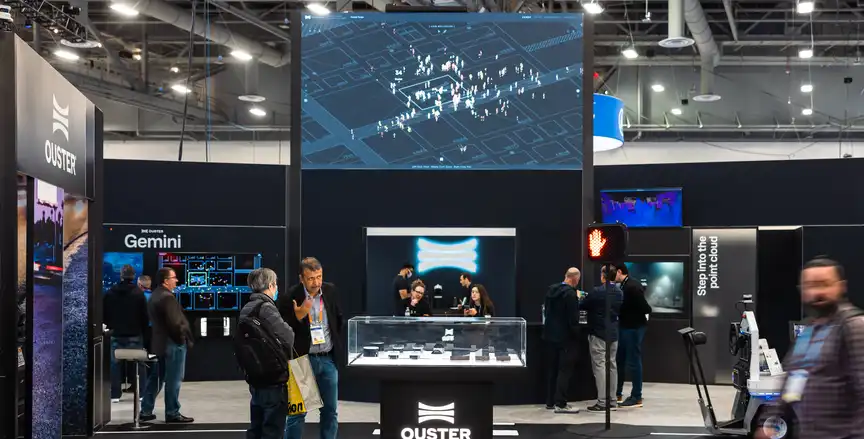Ouster Gemini is a new perception platform for smart infrastructure and optimized for digital lidar. It enables a new spatial intelligence for monitoring retail stores, securing sensitive sites, or tracking city traffic, and offers an alternative to camera-based systems that are common for existing applications. The system guarantees anonymous tracking and counting of people and objects, resulting in centimeter-accurate spatial object information that can be used for crowd analysis purposes. The platform can cover large areas due to the combination of multiple lidar sensors, making object tracking across space easier.
How it works
The platform consists of three components: multiple lidar sensors, an edge processor, and analysis software. Ouster’s different sensors can be set up in the coverage area of choice and stitched together to expand a coverage area. These can be installed on the ceiling or walls and connect back to an Ouster Catalyst edge processor, which is used to connect and align the different sensors, as well as building zones for tracking and alerts, and processing the collected data. Without obstructions, the coverage area of Ouster’s sensors can range from 1,200 to 70,000 square meters. The edge processor outputs the tracking data for visual analysis or alerts through an API or GUI to Ouster Detect software.
Gemini enables customers to cover more square meters with fewer sensors, reducing the time and cost of integration. A space is represented in 3D with live feeds from multiple lidar sensors that provide one continuous view. Customers can set up their own inclusion/exclusion/event zones in 3D and output real-time or aggregate analytics associated with each zone.
Providing an alternative to camera-based systems
Compared to using cameras, lidar sensors capture the presence and motion of human beings without revealing who they are. The data captured by Ouster’s sensor is not detailed enough to visually identify a person. The system helps companies that capture crowd-analysis data to comply with privacy laws and reduce the risk of data leaks. In addition to this, lidar provides an alternative to complex, inaccurate and unreliable camera systems, and reduces the total amount of required sensors to cover a large area due to their large ranges.
Lidar also enables accurate people detection through day and night, where cameras and radar result in inaccurate or incomplete counting statistics, preventing double-counting. The movement analysis can also distinguish between visitors passing through, and those stopping and spending time in a location. The system collects data regarding total visitors in an area, unique visitors, total time spent, full travel path and more.
Three main use cases
Ouster Gemini is already used to monitor crowds in stores, casinos, stadiums, and transportation hubs. There are three main use cases: crowd and retail analytics, monitoring and security, and intelligent transport systems. The platform helps understand traffic flow and user journeys in real time for crowd and retail analytics. For monitoring and security, the system can be used for creating keep-out zones and triggering real-time alerts, as well as monitoring outdoor spaces like fence lines and gates. For intelligent transport systems, Ouster Gemini provides high-accuracy vehicle and pedestrian counting, analysis of patterns in traffic flows, and building digital twins of intersections and roadways with real-time monitoring.
Crowd analysis in practice: CES 2023
During the CES 2023 tech exhibition, Ouster used its own system for crowd analysis. Specifically, it was used to measure three different metrics to define visitor behavior: draw, intent, and engagement. Draw data illustrates the success rate of drawing visitors into a space - in this case, the Ouster booth at CES 2023 - measuring the number of passers-by and those who visit the booth. Intent metrics serve to conclude on what people want, such as the first place that is visited, where people go from there, and whether they make a purchase at the booth or not. Engagement metrics provide insight into how people engage with products or employee support. Based on the data, Ouster now knows when to cut back on staff and when to provide more, such as during lunch hours with sudden visitor peaks but not enough staff to attend these.






